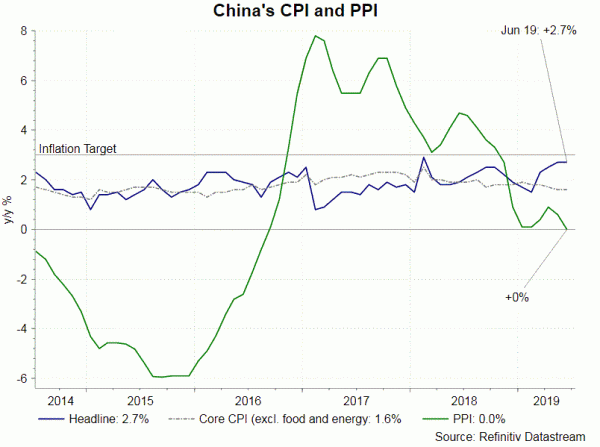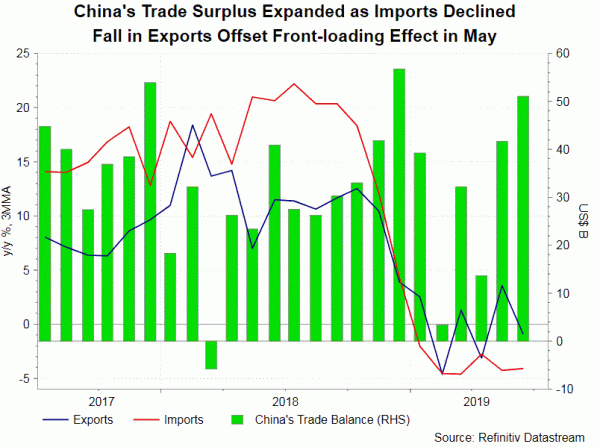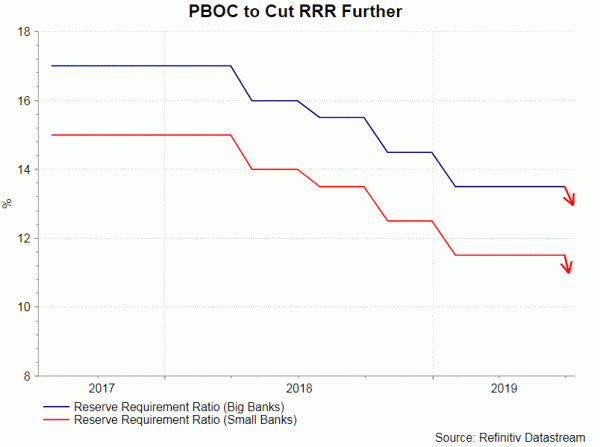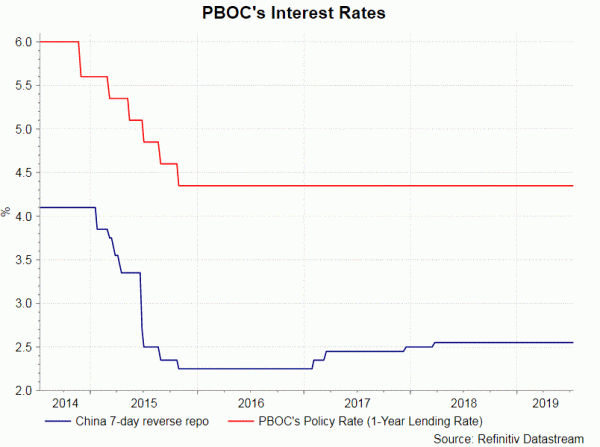China headline CPI stayed unchanged at 2.7% y/y in June. Most of the increase was driven by food price. While African swine fever has caused pork price to soar, extreme weather affected harvest, sending fruit price higher. Food price jumped +7.7% in May from a year ago. Excluding food prices, CPI gained +1.7%.
Core inflation Excluding food and energy prices, CPI rose +1.6%. From a month ago, inflation contracted -0.1%. Upstream price level remained pressured. PPI slowed further to 0%, compared with +0.6% in May and consensus of +0.3%
 Trade surplus widened to US$50.98B in June, beating consensus of US$44.65B and May’s $41.66B. The apparent strong headline reading was due to weak imports, reinforcing slowdown in Chinese growth. Exports contracted -1.3% y/y, after a +1.1% growth in May. This affirms our judgment that Mays’ growth was driven by front-loading.
Trade surplus widened to US$50.98B in June, beating consensus of US$44.65B and May’s $41.66B. The apparent strong headline reading was due to weak imports, reinforcing slowdown in Chinese growth. Exports contracted -1.3% y/y, after a +1.1% growth in May. This affirms our judgment that Mays’ growth was driven by front-loading.
Shipment to the US slumped -7.8%, deteriorating from -4.1% a month ago. Contraction was also seen in the EU with a decline of -3%, following a +6.1% growth a month ago. Exports to Japan eased to +2.4%. Lower demand from advanced economies evidenced genuine of global slowdown.
Concerning emerging markets, exports to Taiwan grew +5%, sharply lower May’s +12.8%, while exports growth to Korea accelerated to +3%, from +1.8% in May. China’s exports to ASEAN also jumped significantly to +12.9%, from +3.5% a month ago.
Import declined -7.3% y/y, following -8.5% in May. The market had anticipated a -4.5% contraction. Domestic demand in China has been weak. Weakness in commodity imports signals moderation in industrial production, likely hurt by US-China trade war.
Major Data Due Next Week
China would release GDP growth for the second quarter, together with industrial production (IP) growth, retail sales and fixed asset investment in June, next week. Economic developments over the past months signaled that growth decelerated in 2Q19 from the prior quarter.
Meanwhile, there could be downside surprise to market expectations of a pickup in IP growth. Manufacturing PMI, by Markit/ Caixin, dropped to 49.4 in June, from 50.2 a month ago. This is the second lowest level since June 2016. The report also shows that “output” and “new orders” sub-index fell for first time since January, while “exports” declined – predicting contraction in exports trade.
As the report concluded, “China’s economy came under further pressure in June” as “domestic demand shrank notably, foreign demand was still underpinned by front-loading exports, and business confidence fell sharply”.
Government’s Policy Outlook
China should remain accommodative in both monetary and fiscal policies in order to stimulate growth. PBOC would adopt a accommodative monetary policy via further RRR cut and rate cut. We expect the latter is increasingly likely. The Fed is expected to cut policy rates, possibly twice, this year. This has reduced the risk that a rate cut in China would accelerate capital outflow. One factor deterring rate cut could be inflation, though. However, as headline CPI has remained below PBOC’s target of +3%, we believe PBOC prioritize growth stimulation over curbing inflation
On fiscal stimulus, Premier Li Keqiang last week announced measures to improving export tax rebate policies and lowering export insurance fees. This, together with other tax cuts announced last year, aims at boosting growth by leaving money at the hands of households and businesses.















